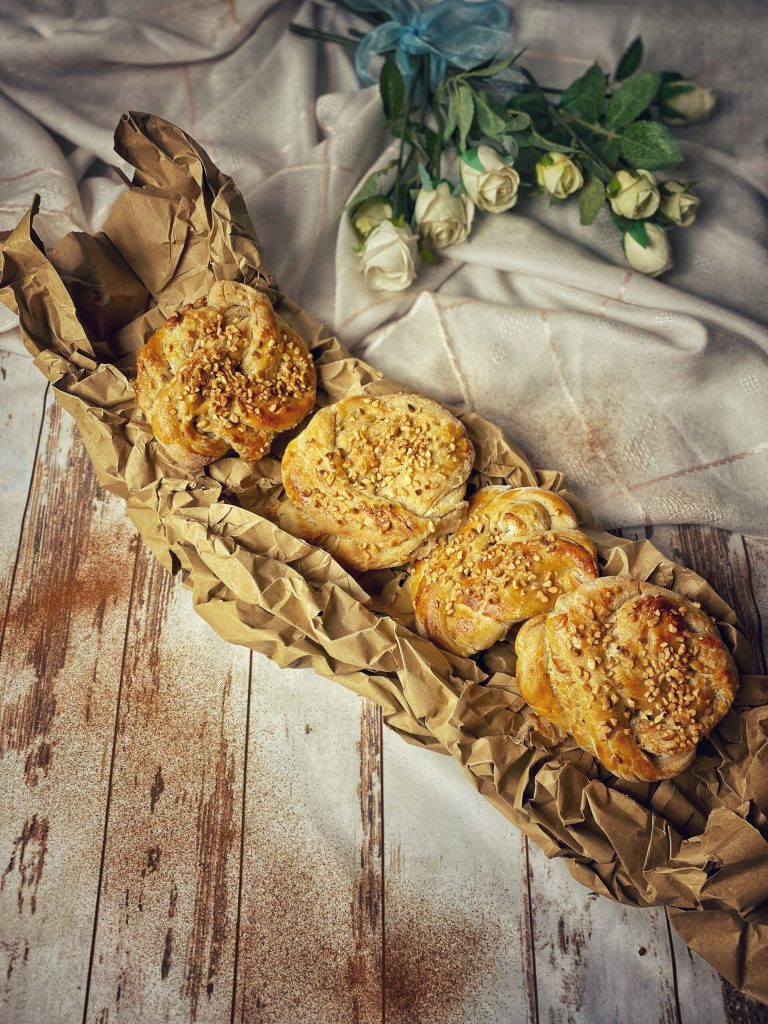The Kanelbulle (kanelbullar plural), also called kanelsnecka and kanelsnurra and in Finnish Swedish örfil, is a sweet treat made from leavened dough filled with cinnamon and cardamom, topped with granulated sugar and optionally almond flakes.
It is often associated with the Swedish fika culture, a relaxing break with coffee or tea.
Kanelbullar are available in various varieties and are common both in North America (cinnamon rolls) and in Northern Europe.
In Sweden, there is evidence of wholemeal bread called kanelbull at least since 1850. The variant that was later called kanelbulle bun was probably created in Sweden in the 1920s when the availability of ingredients increased after World War I.
However, it wasn’t until the 1950s that kanelbullar became common in Sweden.
The Swedish Butterkaka and Finnish Bostonkakku (“Boston cake”) are cakes prepared by baking the cinnamon rolls in a round cake pan instead of baking them separately, so they stick together and form a large round cake.
October 4th is Kanelbullens dag (Cinnamon Bun Day).

- Difficulty: Hard
- Cost: Inexpensive
- Rest time: 2 Hours 30 Minutes
- Preparation time: 10 Minutes
- Cooking methods: Oven
- Cuisine: Swedish
- Seasonality: All seasons
Ingredients
- 4 cups flour
- 1 cup milk
- 0.92 cup sourdough starter (or 18 g baking powder)
- 1/4 cup sugar
- 6 tbsps butter
- to taste cinnamon powder
- to taste cardamom powder
- 1 egg
- to taste almonds (chopped or flaked)
Steps
Dissolve the yeast in warm milk.
Mix the flour with the sugar, add the milk with the yeast.
Knead the dough and let it rise for 1 hour, covered.
Prepare the filling with butter, cinnamon, and cardamom.
Roll out the dough and spread the filling on it, then fold the dough over itself and let it rise for another hour and a half, covered.
Cut strips from the rolled-out dough using a pizza cutter.
Roll each strip onto itself as shown in the VIDEO, closing it in the center like a knot.
Place each piece on a baking sheet, brush with beaten egg, sugar, and almond granules.
Bake in an oven at 356°F (180°C) for 20-25 minutes.

FAQ
What is Swedish Fika?
Fika is a social phenomenon, a legitimate reason to set aside a moment for quality time.
It can occur at any time, morning and evening. It can be enjoyed at home, at work, or in a cafe.
With colleagues, family, friends, it is a tradition frequently observed, preferably several times a day.
There is also a book on the subject, where kanelbullar are mentioned: “Fika & Hygge” by Brontë AurellWhat are other names for kanelbulle in Europe?
In Denmark, it is known as kanelsnegl, and they are particularly popular on Wednesdays, when an extra-large variant called “Wednesday snail” is sold. This tradition was specifically invented during the 1990s when the national football team usually played its matches on Wednesdays.
In Norway as kanelbolle, skillingsbolle, kanelsnurr or kanel i svingene, in Finland as korvapuusti, in Iceland as kanilsnúður and in Estonia as kaneelirull.
In Sweden, variants such as vaniljbulle (vanilla roll), prepared similarly but flavored with vanilla instead of cinnamon, and toscabulle (Tosca roll), without cinnamon and topped with a butter and almond flake glaze.
Between Austria and Germany, it is called Zimtschnecke. In Slovakia and the Czech Republic, it is called osie hniezdo/vosí hnízdo (meaning “wasp nest”) and can also be found in a conical spiral form.
Here, they are often filled with cinnamon filling or may have nut, cocoa, or vanilla pudding.What are the differences between kanelbulle and cinnamon roll?
American cinnamon rolls are often larger, baked in a pan, and topped with icing (usually sugar glaze) and sometimes are fried, finished with glaze, and served as a variant of a donut. They do not contain cardamom.
Another difference is that cinnamon rolls are usually baked in a pan side by side, creating that soft crumb, while kanelbullar are baked separately, some even put them in muffin liners or they are spaced enough so that they do not touch.
The shape of cinnamon rolls is a roll, while kanelbullar may have a shape more akin to a snail since one end is folded underneath at the center, or a shape similar to a knot.
There are also regional combinations: in the American Midwest, particularly in Nebraska and Kansas, they are commonly eaten with chili.

